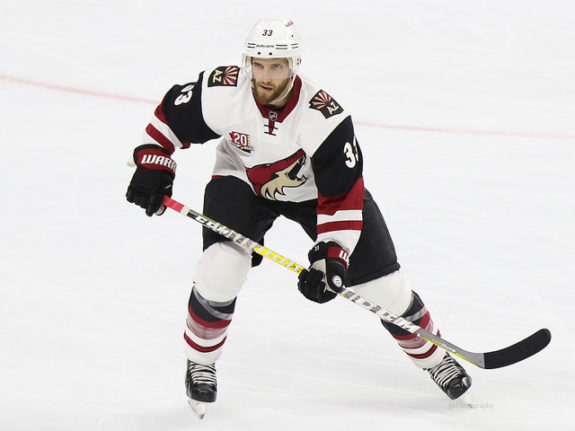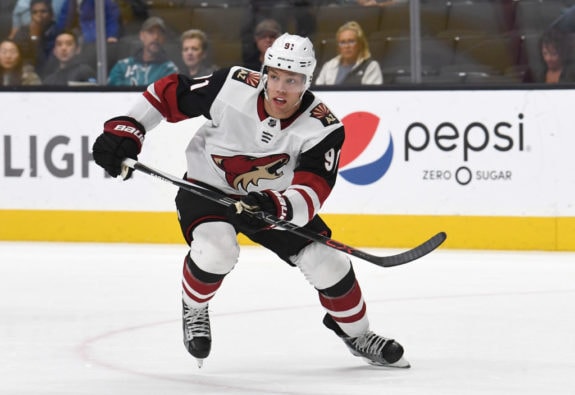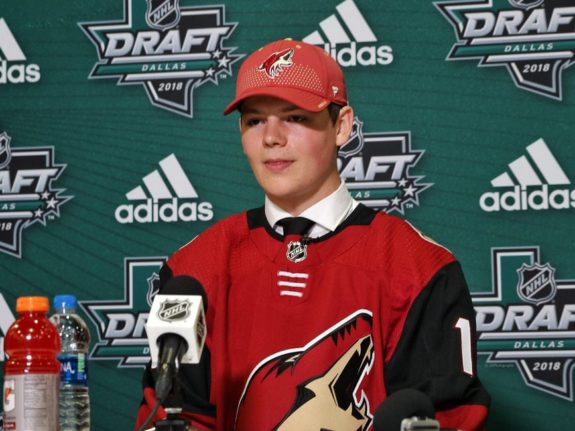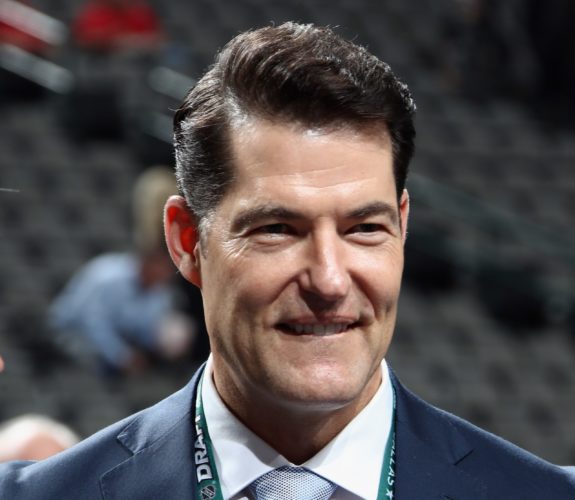Three weeks ago at this time, there likely weren’t many individuals in hockey circles that could have imagined the Arizona Coyotes might potentially be buyers at the 2021 NHL trade deadline, which is coming up at noon on April 12. At the end of play on March 18 (20 days ago), the team was mired in a five-game losing streak, during which they blew a 2-0 lead to the West Division’s last-place team, were shut out twice, and scored just a single goal on two other occasions. A three-game road trip to Minnesota came and went, with the Coyotes earning no points against a surging Wild team that made it look easy in the third period of all three contests.
The team had hung around the .500 mark all season long, but it seemed like things were beginning to unravel. Trade rumors were already swirling around the franchise, with veteran players like Alex Goligoski, Jason Demers, Antti Raanta, Darcy Kuemper, and others being mentioned as potential targets for the league’s buyers. Even cornerstone pieces like Conor Garland and Clayton Keller were brought up as possibilities, but the actual validity of these claims remains unknown to those of us who are not employed in an NHL front office.

Since that blown two-goal lead in Anaheim on March 18, though, the Coyotes have played some outstanding hockey. They’re 7-2-0 in their last nine contests, with the only two losses coming at the hands of the red-hot Colorado Avalanche, who, as of this writing, are in the midst of a 15-game point streak, at 13-0-2 since March 8.
In the seven wins, Arizona received contributions from throughout the lineup, as four different skaters have recorded hat tricks during that stretch of action. Derick Brassard carried the ‘Yotes to victory with his first-career regular-season hat trick on March 20 in Anaheim, and Phil Kessel joined the party with a natty hatty a week later on March 27 in Glendale against the San Jose Sharks.
Jakob Chychrun then provided the franchise’s first defenseman hat trick in over 10 years on April 4 at the Honda Center, and rookie Michael Bunting ended the club’s 24-hour hat-trick drought by getting one in his ninth career NHL game on April 5 in Los Angeles, beating former captain Shane Doan to the milestone by approximately 1,150 games.
Thanks to their vastly improved output at the offensive end (3.78 goals per game since March 19 – third in the league), the ‘Yotes have rocketed up the West Division standings and will enter play on Wednesday with a five-point lead on the St. Louis Blues and San Jose Sharks with just 17 games remaining.
As a result, they’ve quickly moved from the “sure-fire sellers” column to the “deadline buyers” category.
What Can Arizona Give Up?
Before we dive into potential areas of need for this team at the trade deadline, we have to take a look at the pipeline and see if there are any future assets that general manager Bill Armstrong could deal in an effort to help his current roster return to the playoffs for a second consecutive season.
The answer? There’s not a lot in the cupboard to work with.
Much has been made of the punishment handed down to Arizona by the league in regards to the prospect fitness testing scandal that made headlines last year, and those sanctions were indeed severe. The incident, which happened under the watch of former GM John Chayka, resulted in the Coyotes losing their 2021 first-round draft pick, as well as their second-rounder in the now-complete 2020 draft.
Compounding matters is the large price that Chayka paid to rent Taylor Hall from the New Jersey Devils last season – in that trade, Arizona surrendered their 2020 first-rounder, their 2021 third-round choice, and three prospects (Nick Merkley, Nathan Schnarr, and Kevin Bahl).

Between the Hall trade and the “Chaykagate” sanctions, the ‘Yotes were left with only one pick in the first three rounds of the upcoming 2021 Entry Draft, which is their own second-rounder. Additionally, the 2020 draft class will almost certainly produce zero NHL players, as Arizona didn’t select until the fifth round, at No. 142 overall. For 2021, the Coyotes did manage to acquire another second-round pick in the trade that sent Derek Stepan to the Ottawa Senators on Dec. 26, 2020, but there’s not a lot here for Armstrong to work with, unless he opts to trade picks from the 2022 draft, which would be ill-advised considering the need to rebuild the organization’s prospect pipeline.
When it comes to young talent, though, the Coyotes have a lot of options. Barrett Hayton, the No. 5 overall pick in the 2018 draft, will turn 21 over the summer and has not developed as was hoped when he was taken ahead of players like Quinn Hughes, Vitali Kravtsov, and Oliver Wahlstrom. He’s played just 34 NHL games so far, and he’s struggled in the AHL with the Tucson Roadrunners this season, with 5 points in 16 games. If the right deal presents itself, I’d have to believe Armstrong would listen to offers on Hayton while he still has value. If Barrett hasn’t yet broken into the league at this time next year, I can’t imagine there being much of a trade market for him.

Victor Soderstrom has also struggled in Tucson, but this is his first year in North America after coming over from Sweden. The 20-year-old right-handed defenseman likely will need some time to adjust to the smaller ice surfaces, and, with an aging NHL blue line, the Coyotes will be more inclined to hang onto this player. The No. 11 overall choice in 2019 is likely safe for now.
Coyotes Need Help on Offense
As is usually the case in Arizona, the No. 1 area of need at the trade deadline is at forward. The club has scored a lot of goals lately, but they’re still sitting at No. 21 in the league in offense this season, at 2.67 goals per game. When it comes to teams in the bottom-15 of the league in this area, only three (the Boston Bruins, Nashville Predators, and Coyotes) currently occupy playoff spots. You have to score goals to be able to win in the modern-day NHL, and the ‘Yotes definitely could use some help at the offensive end of the ice.

After getting arguably the No. 1 forward available last season, don’t expect Arizona to make another big splash in 2021. Taylor Hall will likely be traded again, and is, arguably, the No. 1 forward rental available, but I can’t imagine the ‘Yotes will want to run it back with the former Windsor Spitfires star. Hall’s trade value is down this year, as he’s scored just twice and added 17 assists in 37 games, but he’s playing for a miserable Buffalo Sabres team. He’ll surely be able to find his game once he leaves the land of blue cheese and buffalo wings, but I wouldn’t bet on the Coyotes being interested this time around.
Staying in Buffalo, Jack Eichel’s name has been tossed around in recent weeks, too, but there are a few problems with this. First, the Sabres’ asking price is probably going to be astronomical, and, as we previously discussed, draft-pick capital is in short supply in Arizona at the moment. Second, the Coyotes cannot afford Eichel’s $10 million cap hit.

Third, we’re not allowed to have nice things in the desert – the Coyotes, while losing too many games to get Connor McDavid in the 2015 Draft Lottery, didn’t lose enough games to get Eichel in a cruel twist of fate that still stings six years later. The Hockey Gods simply will not allow this to happen.
Coyotes’ Potential Targets?
As far as more realistic options go, there are not a whole lot of players out there that would significantly move the needle in Arizona – guys like Bobby Ryan, Ryan Dzingel, Kyle Palmieri, and Nick Foligno are likely available, but I’m not sure they’d make a significant-enough impact to be worth the price Armstrong would have to pay.
Nevertheless, Ryan’s name is an interesting one for me – he’s been mostly healthy in 2020-21 after a few injury-plagued campaigns with the Ottawa Senators and has played relatively well, considering he’s on a rebuilding Detroit Red Wings team. The New Jersey native could benefit from a change of scenery, and being thrust back into the midst of a playoff race could rejuvenate him, as he hasn’t been on a competitive club since the 2016-17 Sens went to the Eastern Conference Final. Ryan had a mediocre regular season that year, with 25 points in 62 games, but he had 15 points in 19 postseason games to lead all Ottawa forwards. It’s possible the 34-year-old still has a little left in the tank, and, at only $1 million, the former 30-goal scorer is someone the Coyotes could afford. A mid/late-round draft pick and/or a mid-level prospect should be enough to pry Ryan out of Detroit.

Foligno, the Columbus Blue Jackets’ captain, is also an intriguing candidate. The 33-year-old isn’t the player he once was, but he could provide an upgrade to Arizona’s middle-six while also being a huge leadership presence on the ice and in the locker room. The 949-game veteran has been through it all, and he could help push this young Coyotes forward group across the finish line. Columbus would have to retain some salary here, and Foligno would have to waive his no-movement clause, but I can’t imagine the price would be very high if Armstrong wanted to add the veteran to his lineup.
The Bottom Line
Overall, even though the Coyotes have put themselves in a position to be buyers at this season’s trade deadline, don’t bet on them to make a significant acquisition between now and April 12. I’m sure Armstrong would like to make the playoffs this year, but the current organizational goal is to be in contention on a consistent basis in the near future. Any moves that would mortgage some of the future just to maybe survive an extra game or two in a tough first-round matchup against either the Vegas Golden Knights or Avalanche might not be prudent ones.
However, it has been a long time since playoff hockey has been contested in Glendale, Arizona. The ‘Yotes made an appearance in the Edmonton bubble last summer, but there was no one in attendance for any of the games at Rogers Place. In a year where revenues are down throughout the league due to COVID-19, the possibility of hosting three or more “whiteout” games has to be enticing for the Coyotes’ ownership group.
The club is 17 games away from realizing that goal and has a five-point cushion on their nearest division challenger – what kind of message would it send to the fanbase, which hasn’t seen a postseason game in Gila River Arena in 3,242 days, if the organization sat on their hands and did nothing to help their current roster finish in the West Division’s top four?
More importantly, what would the decision mean to the team, which has played hard to climb back into contention despite the loss of the top-two goaltenders on the depth chart? Armstrong shouldn’t make a move just to make a move, but if the right deal presents itself, the first-year GM should be all over it if the price is right.